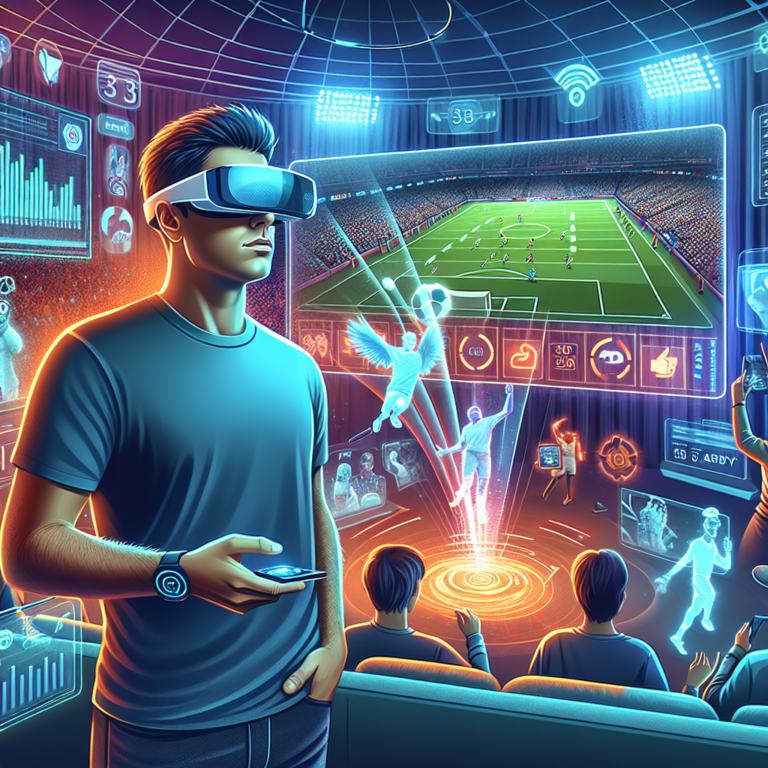Revolutionizing the Game: How Augmented Reality Will Change Live Sports for Remote Fans 🌟
Introduction: A New Frontier in Sports Entertainment
The world of sports is on the brink of a revolution! Imagine being able to watch your favorite team play from the comfort of your living room, but enhanced with augmented reality (AR). As technology evolves, so does the way fans engage with their beloved sports events. Remote fans are no longer just passive observers; they can now become part of the action in ways previously unimagined!
What is Augmented Reality and How Does it Work?
Augmented reality is a technology that overlays digital information—such as images, sounds, and text—onto the real world. Using devices like smartphones, tablets, or AR glasses, fans can see additional content while watching live sports broadcasts. Here’s how it works:
- Overlaying Data: Real-time statistics and player information are displayed on screen, providing deeper insights.
- Interactive Elements: Fans can engage with virtual elements, such as virtually “walking” alongside a player or accessing multiple camera angles.
- Enhanced Social Experiences: Fans can interact with friends in AR spaces, even if they are miles apart.
The Benefits of AR for Remote Sports Fans
The incorporation of augmented reality into the sports viewing experience can offer numerous benefits to remote fans, making every game feel more immersive and interactive. Here are some of the top perks:
1. Real-Time Stats and Player Insights 📊
Imagine watching a basketball game and having player stats, historical performance, and live score updates hovering right beside the action! With AR, fans can access:
- Live player statistics.
- Heat maps showing where players spend most of their time on the field.
- A history of plays to see how a game evolves.
2. Personalized Viewing Experience 🎥
With augmented reality, every fan can customize their viewing experience. They can choose to follow specific players, teams, or even types of plays. The ability to create a tailored experience means that every match can feel like a personal journey. Fans could also select camera angles and virtual viewpoints that fit their preferences.
3. Immersive Fan Communities 🤝
AR technology opens doors to fantastic social experiences, bringing fans together regardless of location:
- Virtual Meetups: Fans can gather in augmented reality spaces to watch games together, share reactions, and compete in games.
- Live Polls and Quizzes: Real-time engagement through quizzes during games can make every play more exciting.
- Chat Features: Integrated chat allows fans to discuss the match without distractions, creating an interactive social atmosphere.
4. Enhanced Game Immersion 🏆
Augmented reality takes immersion to the next level. Instead of watching a game, fans will feel as though they’re part of it:
- 3D Replays: Fans can view impressive plays in 3D, rotating and zooming in for details.
- Live AR Visualizations: Authentic play simulations can give fans a deeper understanding of strategies and techniques.
- Player Avatars: Eager fans can explore a player’s path through a virtual representation of the match.
Bringing Sports Merchandising to Life 🛍️
Augmented reality has fantastic potential in sports merchandising. Just imagine being able to try virtual jerseys or merchandise before purchasing them! This innovation transforms how fans interact with their teams and gear:
- Virtual Try-ons: Fans can see how different jerseys or gear look on themselves through AR.
- Exclusive AR Content: Purchasing gear could unlock AR experiences, like virtual meet-and-greet sessions with players.
Challenges and the Road Ahead 🚧
While the potential of AR in sports viewing is vast, there are a few challenges we need to navigate:
1. Technology Accessibility
Not everyone has access to high-end devices capable of supporting AR experiences. Therefore, making this technology universally available is essential.
2. Content Integration
To maximize impact, sports leagues and broadcasters need to collaborate to create engaging AR content. This ensures a seamless experience while maintaining interest from remote fans.
3. User Training
Educating users on how to utilize AR features effectively is crucial. User-friendly interfaces and tutorials can ease the transition and increase engagement.
Conclusion: The Future is Bright for Remote Sports Fans!
As augmented reality continues to advance, the intersection of technology and sports will evolve in thrilling ways. Remote fans no longer have to feel disconnected from live events. Instead, they can experience unprecedented levels of engagement and interaction.
So strap on your virtual gear and prepare for a future where every game feels like you’re right there in the stadium. With AR paving the way, the only limit is your imagination! 🎉




0 Comments